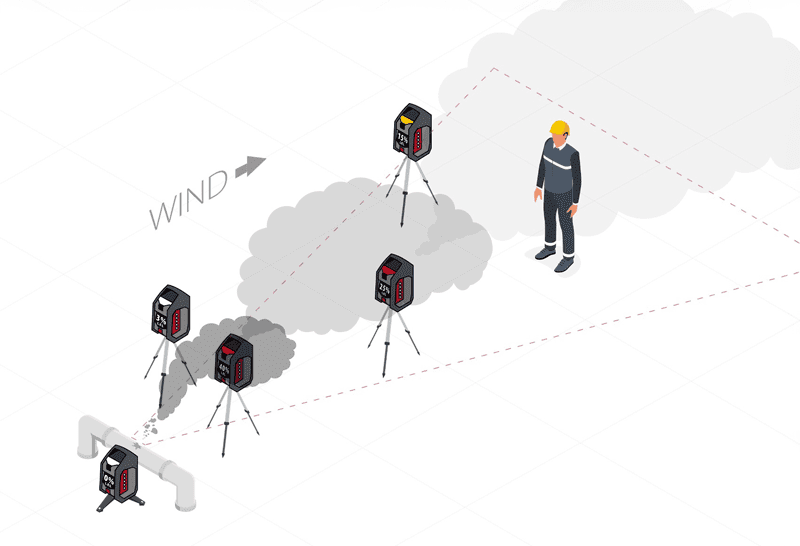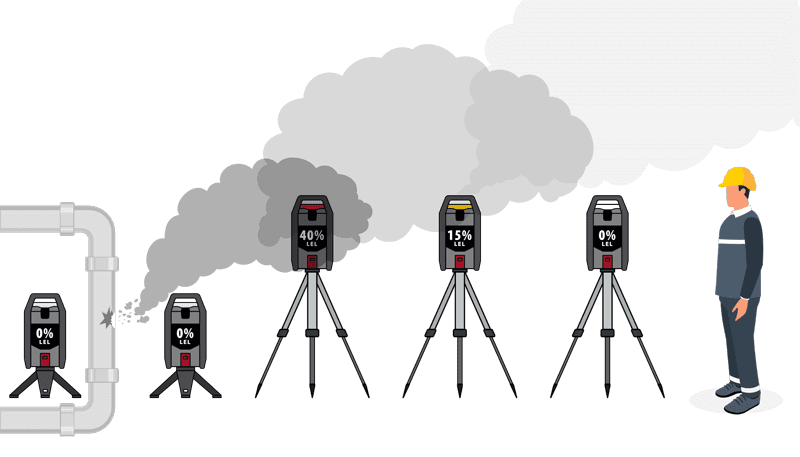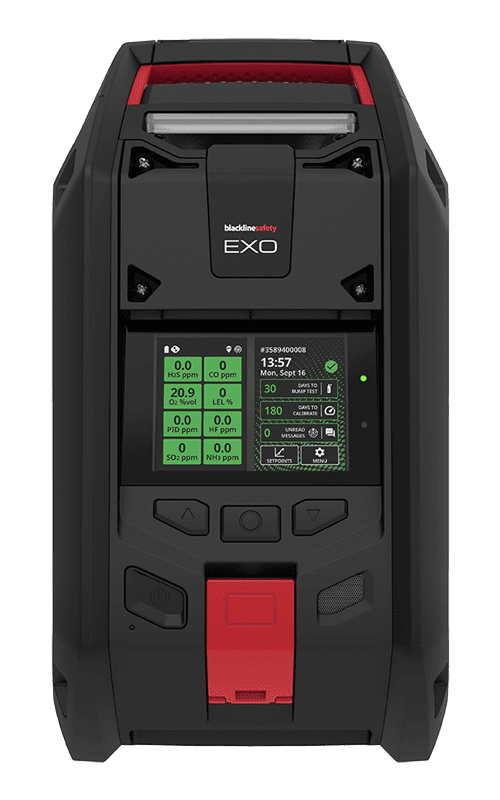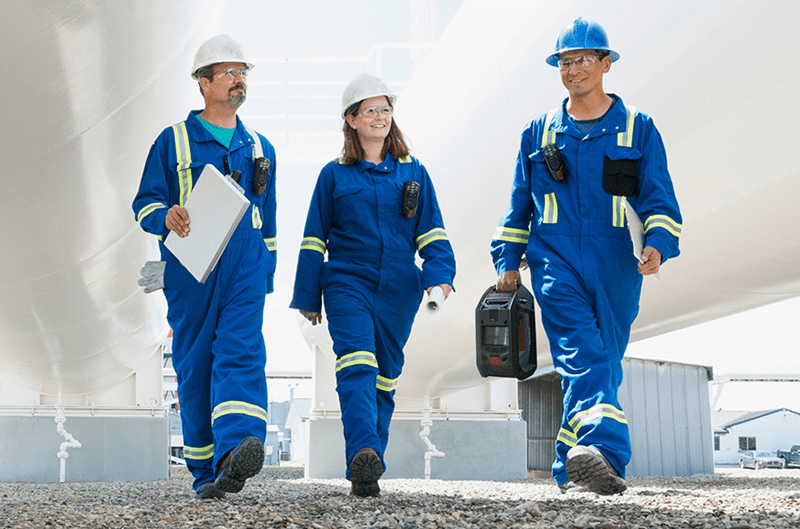There are five key considerations for optimizing safety with area monitoring. Even with simple, drop-and-go deployment, gas detection in an oil and gas facility must go beyond just placing an area gas monitor and assuming everything is safe. That’s because the movement of gas is complicated and influenced by several variables. Knowing how these monitors function, including the breadth of their capabilities but also their limitations, can help ensure they’re working effectively, capturing what’s intended and alerting personnel of any hazards present in the workplace.
A common misconception is that an area monitor detects gas around a fixed radius. That is, once you deploy an area monitor, it will detect gas around that location within a certain number of yards. This is not necessarily true. Multiple factors influence effective coverage, and an area monitor can only detect the gases to which it is exposed.
Five Factors that Impact an Area Monitor’s Coverage and Efficacy
1. Gas Characteristics
Gases possess diverse physical properties, including volatility and relative density compared to air. For instance, hydrogen sulfide (H2S) is heavier than air and so is likely to accumulate in lower spaces or along the ground. Lighter gases like methane (CH4) will rise and disperse upwards and can accumulate at the top of a confined space. Consequently, the placement of detectors for these gases should differ. Knowing which gases are a potential risk, and the characteristics of those gases, is crucial to understanding where an area monitor should be placed to optimize detection.
2. Environmental Factors
Environmental conditions like temperature, wind direction, humidity and atmospheric pressure can substantially affect how gases disperse in the monitored area. Warmer environments, for instance, encourage faster gas dispersion, which means gas monitors in such settings might need to cover larger areas. Wind can carry gases over long distances or concentrate them in certain spots based on direction and intensity. Even if an area monitor is only a few feet from a gas leak, if it’s upwind, it won’t be able to detect gas that doesn’t cross its sensors. Understanding these environmental dynamics is crucial in establishing an effective gas detection strategy.
 3. Gas Sensor Technology
3. Gas Sensor Technology
Not all area gas detection monitors are created equal, and that’s especially true for their gas sensor technology. Sensor types generally used are infrared (IR), catalytic bead, electrochemical, photoionization (PID) or Molecular Property Spectrometer (MPS) – or any combination of those. Each sensor type has its strengths and weaknesses and differs in sensitivity, selectivity and response times. For example, IR sensors can detect certain gases at low concentrations over large areas, but they are not effective for gases that do not absorb infrared radiation. The nature of the detection technology greatly influences the monitor’s coverage area.
4. Area Monitor Location
The monitor’s placement is another determinant of its effective coverage. As mentioned earlier, heavier gases tend to settle in low-lying areas while lighter gases move upward. Strategic placement of monitors can ensure broader and more effective coverage. For example, if H2S gas is the only concern, an area monitor might be deployed directly on the ground but, in the case of CH4, the area monitor could be placed higher up on a tripod. Since gas dispersion can be unpredictable, in addition to area monitors, workers at risk of gas exposure should wear personal gas detectors within their breathing zone (the 10-inch/25cm radius around the nose and mouth) to help ensure their safety.
 5. Physical Structure
5. Physical Structure
Lastly, the physical structure of the space also impacts the gas monitor’s coverage. In confined spaces, gases might accumulate and create pockets of high concentration, while in open spaces, they may disperse more readily. Building structures, such as walls, ducts and partitions, can obstruct or channel gas movement, altering its distribution pattern and concentration and, therefore, the size of a monitor’s coverage.
These factors make the concept of a “set radius” for an area gas monitor too simplistic and generally inaccurate.
Additional Considerations
The five factors listed above need to be considered to determine which device and sensors are best and the placement for the specific location of the area monitor. The application will vary significantly between up-, mid- and downstream facilities. The best practice is to do an engineering survey and analysis based on the specific use case and location using 3D gas modeling. This type of comprehensive risk assessment is critical prior to deployment as it accounts for the type of gas, environmental conditions, detection sensor technology, monitor placement, and the physical space of the location. In this way, an optimized area gas monitoring system that most effectively protects people, processes and property can be deployed.
When that is unavailable, there are standard industry assumptions that can be made. If the source is static, such as a pipeline, it can be assumed to use a 25’ radius when considering the placement of the area monitor taking the above factors into account. If the source is mobile, such as that from CO or NO2 from vehicle exhaust, a 50’ radius can be used.
Deployment should also consider if the intent is to protect workers or the facility/refinery with area gas monitoring. If it is to protect workers, the area monitor should be placed at the height of the breathing zone, but if it’s to monitor and protect the facility, it should be placed at the expected height of the gas.
 Blackline’s EXO 8 area monitor can be placed directly on the ground or on a standoff base, tripod or universal mount, giving maximum deployment flexibility for any application. And it is the world’s only cloud-connected portable area monitor capable of detecting up to eight gases, plus gamma radiation, for the wide variety of possible gases in your oil and gas operations.
Blackline’s EXO 8 area monitor can be placed directly on the ground or on a standoff base, tripod or universal mount, giving maximum deployment flexibility for any application. And it is the world’s only cloud-connected portable area monitor capable of detecting up to eight gases, plus gamma radiation, for the wide variety of possible gases in your oil and gas operations.
Recognizing and Managing Complexity
An area gas monitor’s detection coverage is a dynamic and complex aspect of protecting both your oil and gas workers and their work environment. Its efficacy and range are impacted by the interplay of numerous factors rather than being confined within a rigid radius. Recognizing and managing this complexity are pivotal in ensuring the safe and efficient operation of refineries and other facilities that handle or produce gases.
Randy Gonzales is a regional sales director for Blackline Safety in the western U.S. and Canada region. In this role, he helps drive revenue growth and market share within his area. With over 15 years of experience in various sales roles, Gonzales has developed a reputation for building relationships with customers and partners, delivering exceptional results, and leading high-performing teams. Before joining Blackline, Gonzales worked at leading technology and industrial companies such as GE Digital and Honeywell. He’s passionate about helping customers achieve their business goals and is committed to delivering outstanding customer service and support.






